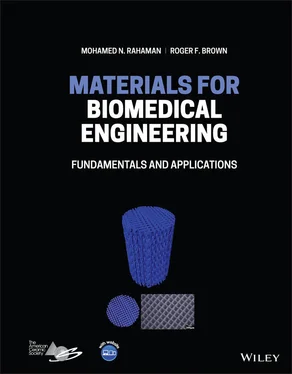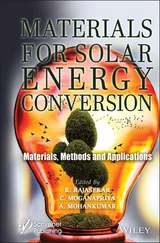Mohamed N. Rahaman - Materials for Biomedical Engineering
Здесь есть возможность читать онлайн «Mohamed N. Rahaman - Materials for Biomedical Engineering» — ознакомительный отрывок электронной книги совершенно бесплатно, а после прочтения отрывка купить полную версию. В некоторых случаях можно слушать аудио, скачать через торрент в формате fb2 и присутствует краткое содержание. Жанр: unrecognised, на английском языке. Описание произведения, (предисловие) а так же отзывы посетителей доступны на портале библиотеки ЛибКат.
- Название:Materials for Biomedical Engineering
- Автор:
- Жанр:
- Год:неизвестен
- ISBN:нет данных
- Рейтинг книги:4 / 5. Голосов: 1
-
Избранное:Добавить в избранное
- Отзывы:
-
Ваша оценка:
- 80
- 1
- 2
- 3
- 4
- 5
Materials for Biomedical Engineering: краткое содержание, описание и аннотация
Предлагаем к чтению аннотацию, описание, краткое содержание или предисловие (зависит от того, что написал сам автор книги «Materials for Biomedical Engineering»). Если вы не нашли необходимую информацию о книге — напишите в комментариях, мы постараемся отыскать её.
A comprehensive yet accessible introductory textbook designed for one-semester courses in biomaterials Materials for Biomedical Engineering: Fundamentals and Applications
Materials for Biomedical Engineering: Fundamentals and Applications
Materials for Biomedical Engineering — читать онлайн ознакомительный отрывок
Ниже представлен текст книги, разбитый по страницам. Система сохранения места последней прочитанной страницы, позволяет с удобством читать онлайн бесплатно книгу «Materials for Biomedical Engineering», без необходимости каждый раз заново искать на чём Вы остановились. Поставьте закладку, и сможете в любой момент перейти на страницу, на которой закончили чтение.
Интервал:
Закладка:
8 Chapter 8Figure 8.1 Types of synthetic polymers relevant to biomaterials.Figure 8.2 Arrangement of monomer units in (a) random copolymer, (b) alterna...Figure 8.3 Arrangement of monomer units in polymers composed of (a) linear c...Figure 8.4 Stereoregularity of molecules in a vinyl polymer such as polyprop...Figure 8.5 (a) Illustration of polymer composed of molecules having many dif...Figure 8.6 Illustration of the conformation of a molecular chain in a molten...Figure 8.7 Schematic plot of the specific volume of a polymer as a function ...Figure 8.8 Effect of chain backbone composition on the glass transition temp...Figure 8.9 Effect of side chains on the glass transition temperature T g. (a...Figure 8.10 Illustration of stages in nucleation and crystal growth in polym...Figure 8.11 Illustration of the structure of a spherulite growing within a m...Figure 8.12 Molecular orientation in amorphous polymers. Extending an amorph...Figure 8.13 Stages of molecular orientation in semicrystalline polymers. Ext...Figure 8.14 (a) Representation of the synthesis of polymethyl methacrylate (...Figure 8.15 Representation of the synthesis of polyethylene terephthalate (P...Figure 8.16 Illustration of the shear modulus as a function of temperature f...Figure 8.17 Chemical structures of three fluorinated hydrocarbon polymers: p...Figure 8.18 Scanning electron microscope image of the microstructure of a po...Figure 8.19 Chemical structure of polyether ether ketone (PEEK).Figure 8.20 Chemical structures of polycarbonate (PC), polyether sulfone (PE...Figure 8.21 (a) Representation of the synthesis of nylon 6.6 by a condensati...Figure 8.22 Chemical structure of polydimethylsiloxane (PDMS).Figure 8.23 Illustration of the synthesis of a polyurethane alternating copo...Figure 8.24 Synthesis of a polyurethane segmental block copolymer by a two‐s...Figure 8.25 Chemical structures of common diisocyanates, polyols, and chain ...Figure 8.26 Schematic representation of the effect of hard segment content (...Figure 8.27 Chemical structures of common water‐soluble polymers. (a) Polyvi...
9 Chapter 9Figure 9.1 Schematic illustration of the cleavage of a hydrolytically unstab...Figure 9.2 Schematic illustration of (a) surface erosion, (b) bulk erosion, ...Figure 9.3 Chemical structure and degradation rate constants for various deg...Figure 9.4 Simplified illustration of (a) acid‐catalyzed and (b) base‐cataly...Figure 9.5 Effect of pH on degradation (molecular weight M relative to initi...Figure 9.6 Effect of molecular weight on (a) degradation (molecular weight M Figure 9.7 Illustration of percolation in a material composed of spherical p...Figure 9.8 Critical thickness L cthat a polymer has to exceed in order to un...Figure 9.9 Chemical structure of the most widely used poly(α‐hydroxy esters)...Figure 9.10 Chemical structure of D‐lactic acid and L‐lactic acid.Figure 9.11 Crystallinity of polylactic‐co‐glycolic acid (PLGA), synthesized...Figure 9.12 Water uptake of polylactic‐co‐glycolic acid (PLGA), synthesized ...Figure 9.13 Approximate half‐life t 1/2(time taken for the molecular weight...Figure 9.14 Chemical structures of polycaprolactone (PCL) and its monomeric ...Figure 9.15 Chemical structures of a polyanhydride synthesized from 1,3‐bis(...Figure 9.16 Erosion kinetics (mass eroded relative to the initial mass) for ...Figure 9.17 Percent crystallinity of copolymer P(CCP‐SA) composed of varying...Figure 9.18 Chemical structures of a poly(ortho ester) under investigation f...Figure 9.19 Chemical structure of polydioxanone.Figure 9.20 Chemical structures of the polyhydroxyalkanoates poly‐3‐hydroxyb...Figure 9.21 Chemical structures of poly(propylene fumarate) (PPF) and its mo...Figure 9.22 Poly(cyclohexane‐1,4‐diyl acetone dimethyl ketal) (PCADK) and ac...Figure 9.23 (a) Scanning electron microscope image of poly(cyclohexane‐1,4‐d...Figure 9.24 Synthesis of poly(glycerol sebacate) (PGS) from glycerol and seb...Figure 9.25 Comparison of the changes in mass, compressive strength, and wat...Figure 9.26 Chemical structure of poly(1,3‐trimethylene carbonate).Figure 9.27 Chemical structure of tyrosine‐derived polycarbonate.
10 Chapter 10Figure 10.1 Illustration of the hierarchical structure of collagen (type I)....Figure 10.2 Scanning electron microscope images of collagen sponge microstru...Figure 10.3 Reaction of glutaraldehyde with the free amino groups of lysine ...Figure 10.4 Denaturation temperature and primary amine group content for der...Figure 10.5 Reaction of (a) hexamethylene diisocyanate with the free amine g...Figure 10.6 Schematic of different collagen structures and their denaturatio...Figure 10.7 Illustration of the mechanical response of collagenous tissues i...Figure 10.8 Typical tensile stress versus strain curves of collagen structur...Figure 10.9 Schematic showing method for extracting gelatin from collagenous...Figure 10.10 Illustration of the hierarchical structure of silkworm silk fib...Figure 10.11 Tensile stress versus tensile strain curves for silkworm ( Bombi ...Figure 10.12 Illustration of elastin in (a) relaxed and (b) stretched states...Figure 10.13 Illustration of major steps in the formation of fibrin.Figure 10.14 Scanning electron microscope image of the structure of fibrin f...Figure 10.15 Two common ways to depict the chemical structure of a monosacch...Figure 10.16 Chemical structure of the repeating unit in hyaluronic acid, co...Figure 10.17 Illustration of the structure of chemically modified hyaluronic...Figure 10.18 Chemical structure of the repeating unit in chondroitin sulfate...Figure 10.19 Representative alginate structure showing (a) chain conformatio...Figure 10.20 Illustration of the formation of a three‐dimensional network of...Figure 10.21 Illustration of a possible reaction scheme for the covalent bon...Figure 10.22 Chemical structure of the repeating unit in (a) chitin, (b) chi...Figure 10.23 Illustration of the chemical modification of chitosan. (a) Ioni...Figure 10.24 Chemical structure of the repeating unit in agarose.Figure 10.25 Chemical structure of α‐glucose and β‐glucose.Figure 10.26 Chemical structure of cellulose.Figure 10.27 Hierarchical structure of cellulose fiber.Figure 10.28 Illustration of the hierarchical structure of bacterial cellulo...Figure 10.29 Scanning electron microscope image of the surface of a bacteria...
11 Chapter 11Figure 11.1 Illustration of a hydrogel in a dehydrated state and in a hydrat...Figure 11.2 Example of the chemical structure of a monomer (hydroxyethyl met...Figure 11.3 Schematic of chemical reaction between polyvinyl alcohol (PVA) c...Figure 11.4 Illustration of alginate hydrogels created by ionic crosslinking...Figure 11.5 Illustration of hydrogen bonded structure between polyacrylic ac...Figure 11.6 (a) Chemical structure of polymers (referred to as Pluronics) co...Figure 11.7 Illustration of the gelling mechanism upon warming a solution of...Figure 11.8 Illustration of gelling in polyvinyl alcohol (PVA) by a crystall...Figure 11.9 Illustration of the mesh size ξ and molecular weight betw...Figure 11.10 Illustration of the contributions to the overall Gibbs free ene...Figure 11.11 Dependence of the molecular weight between crosslinks  and the...Figure 11.12 (a) Illustration of solute (drug) release through a hydrogel; (...Figure 11.13 Illustration of types of structural features that may be presen...Figure 11.14 Degree of ionization of (a) the (C=O)OH group in polyacrylic ac...Figure 11.15 Illustration of the mechanism of swelling for a polyelectrolyte...Figure 11.16 Theoretical predictions for the equilibrium swelling Q as a fun...Figure 11.17 Schematic illustration of the trend in the kinetics of swelling...Figure 11.18 Schematic illustration of typical phase diagrams for polymers s...Figure 11.19 Chemical structures of polyethylene glycol (PEG) and polyethyle...Figure 11.20 N ‐Hydroxysuccinimidyl‐activated esters used to couple the N ‐ter...Figure 11.21 Schematic illustration of the creation of a degradable PEG‐base...Figure 11.22 Measured erosion (mass m relative to initial mass m o) as a func...Figure 11.23 (a) Chemical structure of the monomer unit in N ‐alkyl‐substitut...Figure 11.24 (a) Chemical structure of lightly crosslinked hydrogels compose...Figure 11.25 Chemical structures of chitosan and disodium glycerol phosphate...Figure 11.26 Elastic modulus as a function of temperature for chitosan–glyce...Figure 11.27 Illustration of drug release from polyelectrolyte hydrogels by ...Figure 11.28 Illustration of a method for encapsulating cells in a polyethyl...Figure 11.29 Illustration of a common approach in which hydrogels are used a...
and the...Figure 11.12 (a) Illustration of solute (drug) release through a hydrogel; (...Figure 11.13 Illustration of types of structural features that may be presen...Figure 11.14 Degree of ionization of (a) the (C=O)OH group in polyacrylic ac...Figure 11.15 Illustration of the mechanism of swelling for a polyelectrolyte...Figure 11.16 Theoretical predictions for the equilibrium swelling Q as a fun...Figure 11.17 Schematic illustration of the trend in the kinetics of swelling...Figure 11.18 Schematic illustration of typical phase diagrams for polymers s...Figure 11.19 Chemical structures of polyethylene glycol (PEG) and polyethyle...Figure 11.20 N ‐Hydroxysuccinimidyl‐activated esters used to couple the N ‐ter...Figure 11.21 Schematic illustration of the creation of a degradable PEG‐base...Figure 11.22 Measured erosion (mass m relative to initial mass m o) as a func...Figure 11.23 (a) Chemical structure of the monomer unit in N ‐alkyl‐substitut...Figure 11.24 (a) Chemical structure of lightly crosslinked hydrogels compose...Figure 11.25 Chemical structures of chitosan and disodium glycerol phosphate...Figure 11.26 Elastic modulus as a function of temperature for chitosan–glyce...Figure 11.27 Illustration of drug release from polyelectrolyte hydrogels by ...Figure 11.28 Illustration of a method for encapsulating cells in a polyethyl...Figure 11.29 Illustration of a common approach in which hydrogels are used a...
Интервал:
Закладка:
Похожие книги на «Materials for Biomedical Engineering»
Представляем Вашему вниманию похожие книги на «Materials for Biomedical Engineering» списком для выбора. Мы отобрали схожую по названию и смыслу литературу в надежде предоставить читателям больше вариантов отыскать новые, интересные, ещё непрочитанные произведения.
Обсуждение, отзывы о книге «Materials for Biomedical Engineering» и просто собственные мнения читателей. Оставьте ваши комментарии, напишите, что Вы думаете о произведении, его смысле или главных героях. Укажите что конкретно понравилось, а что нет, и почему Вы так считаете.












